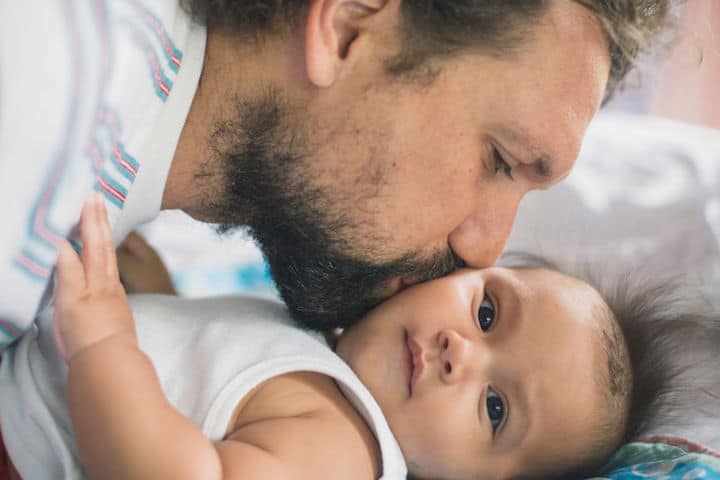While it’s hard to ever be 100% ready for a baby, I’m a strong believer in the saying, “every baby comes with a loaf of bread.” Meaning, every baby comes with all sorts of blessings, including financial ones. As a CPA, I’m happy to report that some of these financial blessings come in the way of tax breaks like the $2,000 child tax credit.
Here are some things to consider to be sure you’re taking advantage of all the tax perks that come with a new baby.
1. Request a social security number
The first and most important tax-related task after your baby is born is to request their Social Security number. In addition to proving your child’s identity, from a parent and tax perspective, a Social Security number is needed to be eligible to claim the child tax credit/additional child tax credit. Tax credits lower your tax bill dollar-for-dollar, and starting in 2018 and continuing into 2019, the child tax credit is worth up to $2,000 per qualifying child.
You can request your child’s Social Security number in the hospital while also completing their birth certificate paperwork. Yes, you can request a Social Security number later using Form SS-5, but it’s much easier to do it while still at the hospital and before sleep deprivation sets in.
Speaking of birth certificates, I recommend ordering several copies since you will need to provide an original copy for things like opening a bank account, receiving insurance benefits, childcare and school registrations, obtaining an identification card or driver’s license, travel, and applying for a passport.
2. Review and update your employer benefits
Having a new baby is a qualifying life event that can make you eligible to change your benefits outside the yearly open enrollment period. Depending on the benefits provider, you may have 30 or 60 days to add your child to your health insurance policy and make any other necessary changes to your employer-sponsored benefits, including health savings accounts (HSA) or flexible spending accounts (FSA).
3. Consider starting a Dependent Care FSA…
If your employer provides a Dependent Care FSA, and you’ll be paying for childcare to allow you to return to work, you may want to consider contributing to this pre-tax account. You can contribute up to $5,000 per year to pay for qualified child care expenses, such as daycare, preschool, nanny, before or after school programs, and summer day camps for children under age 13, if you are married and filing jointly. Be sure to keep track of the receipts for your expenses once it’s time to file a claim and be reimbursed from your FSA.
Keep in mind, you can only use these funds for qualified child care expenses and they do not roll over from year to year. So if one parent later decides to stay home or a grandparent watches Junior in exchange for hugs and kisses, you may be out that money sitting in the FSA account.
4. and, utilizing the Child and Dependent Care Tax Credit
If your employer doesn’t offer a Dependent Care FSA, you may be able to take advantage of the Child and Dependent Care Tax Credit. Once again, if you are paying for childcare so that you can work, as of 2018, the total expenses you can claim is $3,000 for one child and $6,000 for two or more children.
The tax credit depends on your income level, starting at 35% of childcare expenses for the lowest income earners and goes down to 20% of childcare expenses for anyone earning $43,000 or more. Therefore, the credit is worth between $600 and $1,050 if you’re paying for the care of one child under age 13, or between $1,200 and $2,100 if you’re paying for the care of two or more children under 13.
Situations where you can use both the Dependent Care FSA and the Child and Dependent Care Tax Credit
If you have multiple kids and contribute to a Dependent Care FSA, you can take also take advantage of the Child and Dependent Care Tax Credit. The $6,000 child care expense cap for the tax credit for two or more kids is $1,000 greater than the FSA contribution limit. Therefore, you can also calculate the Child Care Tax Credit on the remaining $1,000 that was “unreimbursable” from your FSA. Depending on your income level, that could save you another $200 to $350 on taxes.
If you still need help deciding whether to contribute to a Dependent Care FSA or use the Child Care Tax Credit, this blog post goes into more detail about each option.
5. Be aware of tax requirements when hiring a nanny
If you decide to hire a nanny instead of pay for daycare, you may be subject to nanny taxes. For 2018, once you pay a nanny or any household employee $2,100 or more in a calendar year (or $1,000 or more in a calendar quarter) you have now become an employer in the eyes of the IRS. You will now be responsible for paying the employer portion of your nanny’s Social Security, Medicare, and related unemployment taxes. You will also be responsible for withholding and remitting your nanny’s portion of their Social Security, Medicare, and income taxes. You can either have additional taxes withheld from your own paycheck or make quarterly estimated tax payments to cover your additional tax responsibilities.
You’ll also need both a federal and state tax identification number in order to report your nanny taxes. You’ll also need to file quarterly state tax returns, provide your nanny with a W-2 at the end of the year, report their wages to the Social Security Administration, and file Schedule H as part of your annual tax return. If that sounds like too much hassle, there are agencies that can take care of these tax reporting requirements for you.
6. Track qualifying adoption expenses to claim the adoption credit
If you’ve decided to grow your family by adopting a child, the tax laws also provide some financial assistance to offset the high costs of adoption. If your employer provides benefits for adoption assistance, those can be excluded from income. Adoptive parents can also use the adoption credit, which is worth as much as $13,840 as of 2018. The tax credit is nonrefundable, which means it’s limited to your tax liability for the year. Any credit in excess of your tax liability may be carried forward for up to five years, which is helpful since adoption can be a multi-year process.
Qualified adoption expenses include things such as:
- Reasonable and necessary adoption fees
- Court costs and attorney fees
- Traveling expenses (including amounts spent for meals and lodging while away from home), and
- Other expenses that are directly related to and for the principal purpose of the legal adoption of an eligible child
If you adopt a special needs child, you are generally able to claim the full credit amount in the year the adoption is finalized, even if your actual adoption costs are less. According to the IRS, “special needs adoptions” are the adoptions of children whom the state’s child welfare agency considers difficult to place for adoption.
7. Save for future education expenses
529 plans are a great way to save for your child’s college education. And as an extra perk, some states allow you to deduct some or all of your qualifying 529 plan contribution for state income tax purposes. In 2018, you can contribute up to $15,000 per year to your child without a gift tax liability. If you’re married, you and your spouse can contribute and give up to $30,000 per person, per year. In the case of 529s, you can make five years’ worth of contributions at once ($75,000 for an individual, $150,000 for a married couple) before being liable for the federal gift tax.
If you aren’t sure whether your child will attend college, 2017’s tax reform now allows 529 plan distributions to be used tax-free for private elementary and secondary school expenses. The limit is $10,000 in qualifying expenses per student each year. This includes both public, private, or religious schools. However, not every state will follow the new tax provisions, so be sure your state 529 plan conforms to federal changes before using those funds to pay for private high school.
Another tax-friendly option for college savings is a Roth IRA. While the contribution limits are lower than a 529 plan at $5,500 per year ($6,500 if you’re over 50) for 2018 and $6,000 per year ($7,000 if you’re over 50) starting in 2019, you’ll have a bit more flexibility with how you can use the funds from your Roth IRA. At the same time, Roth IRAs usually have more investment options, which means you can implement your own investment strategy.
Since contributions are made with after-tax dollars, your account can grow tax-free. These contributions can be withdrawn at any time and for any purpose without taxes or penalties. You can also withdraw your earnings penalty-free and tax-free, if they are used for qualified higher education expenses and the Roth IRA account is at least five years old.
8. Save for disability expenses
If your child has a disability, you have the option to contribute to a state’s 529A ABLE account. These are tax-advantaged accounts which can help individuals with disabilities pay for qualified disability expenses. If you initially contributed to a traditional 529 plan for your child and now need to pay for disability expenses, it’s possible to roll over limited amounts from a 529 plan to an ABLE account.
Like a 529 plan used for education expenses, contributions are limited to $15,000 per individual before incurring a gift tax liability. And certain states may allow you to deduct ABLE account contributions on your state income tax return.
Plan for the future
While there are smart tax moves you can make once your new baby arrives, there are also several financial considerations to make while you’re expecting. For example, you’ll want to ensure you have sufficient life insurance coverage and having a dependent means it’s time to do some estate planning. This includes drafting (or reviewing) a will, choosing a guardian for your children, updating beneficiary designations, and possibly creating a trust.
I know that having a baby is an exciting, busy, and yes, expensive time of life. We’ve done it three times! Fortunately, your new bundle of joy comes with a few tax perks to balance out the sleepless nights and countless diaper changes.
Cathy Derus is the founder of Brightwater Accounting. As a CPA and financial planner, she helps individuals and business owners eliminate stress and worry over taxes, business finances, and more. Anyone can throw numbers into tax software. She’s here to help her clients make sense of those numbers and create a better financial strategy for their businesses and lives. Her expertise has been featured in Entrepreneur, CNBC, US News & World Report, The Washington Post, Real Simple and Cosmopolitan.
Haven Life Insurance Agency does not provide tax, legal, accounting or investment advice. This material has been prepared for informational purposes only, and is not intended to provide, and should not be relied on for, tax, legal, accounting or investment advice. You should consult your own tax, legal, and accounting advisors before engaging in any transaction. Individuals involved in the estate planning process should work with an estate planning team, including their own personal legal or tax counsel.





